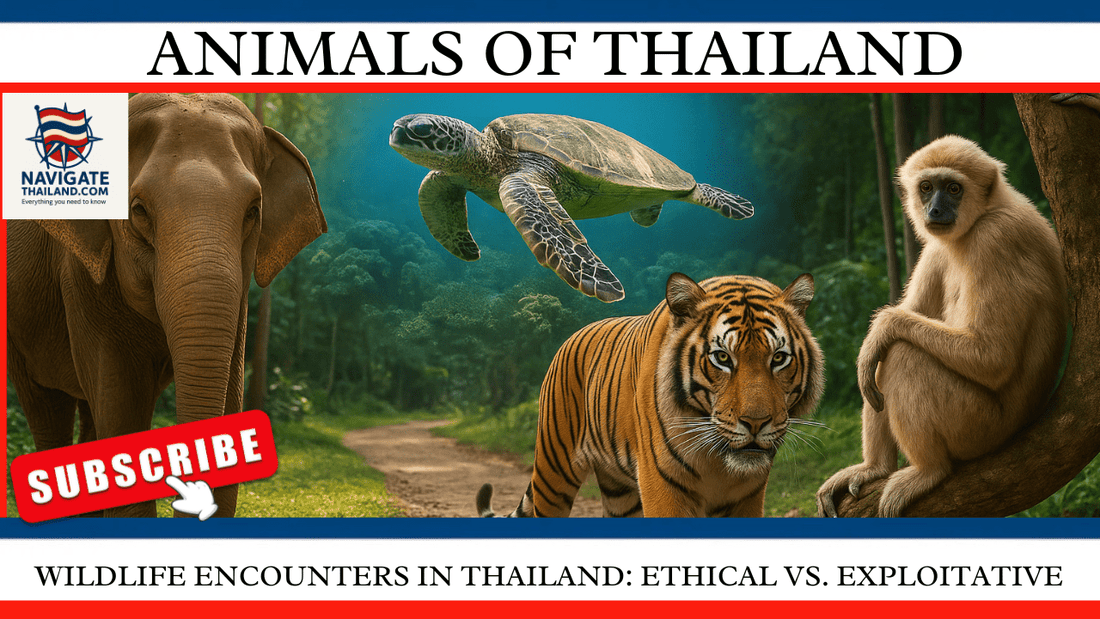
Wildlife Encounters in Thailand: Ethical vs. Exploitative
Share
Thailand’s lush jungles, coral reefs, and vibrant ecosystems offer unforgettable animal encounters—but not all experiences are created equal. While some sanctuaries and national parks protect and conserve Thailand’s wildlife, others exploit animals for tourism dollars, often under the guise of conservation. If you’re planning to see elephants, tigers, monkeys, or marine life in Thailand, it’s vital to understand the difference between ethical and exploitative experiences.
This guide will help you travel responsibly in 2025 and ensure your wildlife encounters benefit both animals and local communities.
Understanding the Spectrum of Wildlife Tourism in Thailand
Wildlife tourism in Thailand ranges from government-protected reserves to roadside tiger photo booths. Some offer valuable conservation and educational opportunities, while others prioritize profit over animal welfare. The key difference often lies in animal behavior, physical condition, freedom of movement, and whether touching or riding is encouraged.
The Red Flags: Signs of Exploitative Animal Tourism
Exploitation often hides behind shiny brochures and social media posts. Here’s how to recognize unethical wildlife attractions:
1.
Elephant Riding and Tricks
Any facility that offers elephant rides, painting shows, or performances is likely prioritizing entertainment over welfare. These elephants are often trained using a cruel method known as phajaan or “breaking the spirit.”
2.
Tigers in Chains or Selfies
If tigers are unnaturally calm, chained, or available for selfies, they are often drugged or abused. These operations rarely contribute to conservation and often operate illegally.
3.
Monkeys Performing Tricks
Street performances or shows where monkeys ride bikes or wear costumes may seem amusing but rely on coercion and stress.
4.
Hands-On Marine Encounters
While swimming with dolphins or manta rays might seem magical, many marine parks confine large ocean animals in small tanks, disrupting their natural behaviors.
5.
Lack of Transparency
If an attraction avoids questions about animal origin, vet care, or conservation efforts, it’s a red flag.
The Green Light: What Ethical Wildlife Tourism Looks Like
Ethical wildlife attractions in Thailand prioritize conservation, education, and animal welfare. Here’s how to recognize a responsible operator:
✅ No Riding, No Touching
Look for sanctuaries where you observe animals at a distance. Ethical elephant sanctuaries allow you to walk alongside elephants, not ride them.
✅ Natural Habitat
Animals should live in open, natural environments—not small cages or concrete enclosures.
✅ Certified and Transparent
Facilities partnered with credible NGOs or wildlife foundations are a safer bet. Look for transparency about their rescue, rehabilitation, and breeding policies.
✅ Focus on Education
A good sanctuary prioritizes learning and raises awareness about animal protection and habitat conservation.
✅ Limited Group Sizes
Small visitor groups reduce stress for animals and show that the experience is designed with their well-being in mind.
Ethical Animal Encounters to Consider in Thailand (2025)
Here are some responsible ways to enjoy wildlife in Thailand this year:
- Elephant Nature Park (Chiang Mai) – A globally recognized elephant rescue center with no riding or shows.
- Wildlife Friends Foundation Thailand (Phetchaburi) – Rescues and rehabilitates all kinds of animals, from gibbons to bears.
- Gibbon Rehabilitation Project (Phuket) – A project focused on rescuing and releasing illegally captured gibbons.
- Mu Ko Surin National Park – Offers snorkeling with wild manta rays and sea turtles in their natural ocean environment.
- Khao Yai National Park – Spot elephants, hornbills, and wild boars on guided treks through protected jungle.
Why It Matters: The Impact of Ethical Choices
Choosing ethical wildlife experiences helps protect endangered species, supports real conservation work, and provides sustainable income for local communities. Exploitative tourism, on the other hand, encourages illegal wildlife trade, poaching, and lifelong captivity.
As a traveller, your baht is your vote—where you spend it can either support cruelty or promote kindness.
Final Tips for Ethical Wildlife Travel in Thailand
- Do your research before booking any wildlife tour.
- Read independent reviews—not just TripAdvisor or glossy websites.
- Avoid any place where you can touch, hold, or ride wild animals.
- Support national parks and NGOs that focus on rehabilitation and release.
- Educate others: your voice on social media can raise awareness.
Conclusion
Thailand is home to some of the world’s most majestic wildlife—but with that beauty comes responsibility. As tourism rebounds in 2025, ethical wildlife travel is more important than ever. Whether you’re walking beside a rescued elephant, snorkeling with sea turtles, or hearing a gibbon’s call echo through the rainforest, let your encounter be one that honors—not harms—the incredible creatures that call Thailand home.
Have you visited an ethical sanctuary in Thailand? Share your experience in the comments below—and tag us in your posts to help raise awareness. Want more travel tips like this? Subscribe to our YouTube channel, or check out our Thailand travel blog series for the latest guides.
References
- World Animal Protection (2024). “Wildlife Tourism in Southeast Asia.”
- Thailand Department of National Parks (2025).
- Wildlife Friends Foundation Thailand (2025).
Read more of our Thailand blog series:
Thai Food Guide:Traditional Recipes and Street Eats
Everything Travellers Need to know
Thailand travel ebooks and language guides
Thailand Travel Apparel & Souvenir Gifts
Subscribe to our YouTube channel Navigate Thailand to see our most popular Thailand travel blogs turned into videos:
Navigate Thailand YouTube channel










































































































































